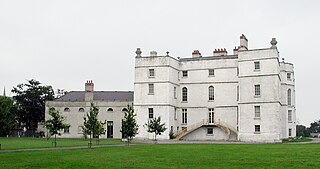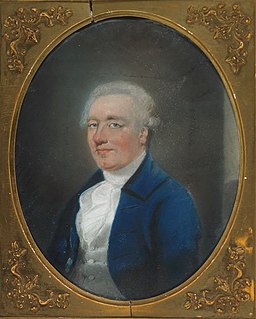
Marquess of Downshire is a title in the Peerage of Ireland. It was created in 1789 for Wills Hill, 1st Earl of Hillsborough, a former Secretary of State.

Marquess of Sligo is a title in the Peerage of Ireland. It was created in 1800 for John Browne, 3rd Earl of Altamont. The Marquess holds the subsidiary titles of Baron Mount Eagle, of Westport in the County of Mayo, Viscount Westport, of Westport in the County of Mayo, Earl of Altamont, in the County of Mayo, Earl of Clanricarde and Baron Monteagle, of Westport in the County of Mayo. All these titles are in the Peerage of Ireland, except the Barony of Monteagle, which is in the Peerage of the United Kingdom. The latter peerage entitled the Marquesses to a seat in the House of Lords prior to the House of Lords Act 1999. The Earldom of Clanricarde was inherited by the sixth Marquess in 1916 according to a special remainder in the letters patent.

Marquess of Ely, of the County of Wexford, is a title in the Peerage of Ireland. It was created in 1800 for Charles Loftus, 1st Earl of Ely. He was born Charles Tottenham, the son of Sir John Tottenham, 1st Baronet, who had been created a baronet, of Tottenham Green in the County of Wexford, in the Baronetage of Ireland in 1780, by Elizabeth, daughter of Nicholas Loftus, 1st Viscount Loftus, sister and heiress of Henry Loftus, 1st Earl of Ely. In 1783 he succeeded to the Loftus estates on the death of his maternal uncle the Earl of Ely and assumed the same year by Royal licence the surname of Loftus in lieu of his patronymic. In 1785 he was raised to the Peerage of Ireland as Baron Loftus, of Loftus Hall in the County of Wexford. It was sold by the family in 1917 and is today owned by the Quigley family.

Marquess Conyngham, of the County of Donegal, is a title in the Peerage of Ireland. It was created in 1816 for Henry Conyngham, 1st Earl Conyngham. He was the great-nephew of another Henry Conyngham, 1st Earl Conyngham, a member of a family of Scottish descent which had settled during the Plantation of Ulster in County Donegal in Ireland in the early 17th century. The 'founder' of the dynasty in Ireland was The Very Rev. Dr. Alexander Cunningham, Dean of Raphoe. The earlier Henry was a member of both the Irish House of Commons and the British House of Commons and served as Vice-Admiral of Ulster and as Governor of the counties of Donegal and Londonderry. In 1753 he was raised to the Peerage of Ireland as Baron Conyngham, of Mount Charles in the County of Donegal, and in 1756 he was created Viscount Conyngham, in Ireland, also in the Peerage of Ireland. In 1781 he was made Baron Conyngham, of Mount Charles in the County of Donegal, with remainder to his nephew Francis Burton, and Earl Conyngham, of Mount Charles in the County of Donegal, which like the creations of 1753 and 1756 was created with normal remainder to the heirs male of his body. The latter titles were also in the Peerage of Ireland. Lord Conyngham was childless and on his death in 1781 the barony of 1753, the viscountcy and earldom became extinct while he was succeeded in the barony of 1781 according to the special remainder by his aforementioned nephew Francis. He was the eldest son of Mary, sister of the first Earl Conyngham, by her husband Francis Burton. The new 2nd Baron Conyngham, who had earlier represented Killybegs and County Clare in the Irish House of Commons, assumed by Royal licence the surname and arms of Conyngham on succeeding to the titles.

Earl of Halifax is a title that has been created four times in British history—once in the Peerage of England, twice in the Peerage of Great Britain, and once in the Peerage of the United Kingdom. The name of the peerage refers to Halifax, West Yorkshire.

Earl of Lisburne is a title in the Peerage of Ireland. It was created in 1776 for Wilmot Vaughan, 4th Viscount Lisburne. He represented Cardiganshire and Berwick-upon-Tweed in the House of Commons and held minor governmental office.

Earl of Antrim is a title that has been created twice, both times in the Peerage of Ireland and both times for members of the MacDonnell family, originally of Scottish origins.

Marquess of Hastings was a title in the Peerage of the United Kingdom. It was created on 6 December 1816 for Francis Rawdon-Hastings, 2nd Earl of Moira.

Rathfarnham Castle is a 16th-century fortified house in Rathfarnham, South Dublin, Ireland.
Viscount Loftus is a title that has been created three times in the Peerage of Ireland for members of the Anglo-Irish Loftus family. The first creation was for Adam Loftus on 10 May 1622, who served as Lord Chancellor of Ireland in 1619. This title became extinct in 1725 upon the death of the third viscount. The second creation was for Nicholas Loftus in 1756, a great-grandson of Adam and a member of the Irish House of Commons. Two of his sons were created earls as Earl of Ely, although both titles became extinct. The third creation of the title was for Charles Loftus in 1789, who became Marquess of Ely in 1800. This title is extant.
A list of the Lord Lieutenants of Fermanagh, located County Fermanagh of Northern Ireland, U.K.
John Butler, 17th Earl of Ormonde, 10th Earl of Ossory (1740–1795) was an Irish peer and Member of Parliament (MP). He represented Gowran between 1776 and 1783, and Kilkenny City between 1783 and 1792. In 1791, his right to the peerage was acknowledged in the Irish House of Lords.

George de la Poer Beresford, 1st Marquess of Waterford, KP, PC (Ire) was an Irish politician, known as George Beresford, 2nd Earl of Tyrone from 1763 to 1789.

Henry Loftus, 1st Earl of Ely KP, PC (Ire), styled The Honourable from 1751 to 1769 and known as Henry Loftus, 4th Viscount Loftus from 1769 to 1771, was an Anglo-Irish peer and politician.

Charles Tottenham Loftus, 1st Marquess of Ely, KP, PC was an Anglo-Irish peer and politician.

Nicholas Hume-Loftus, 1st Earl of Ely PC (I) was an Anglo-Irish peer and member of the House of Lords.
Nicholas Hume-Loftus, 2nd Earl of Ely was an Anglo-Irish peer, briefly styled Viscount Loftus in October 1766.
Charles Tottenham was an Irish Member of Parliament.

Nicholas Loftus, 1st Viscount Loftus PC (I) was an Anglo-Irish politician and peer.
Sir John Tottenham, 1st Baronet was an Anglo-Irish politician.









